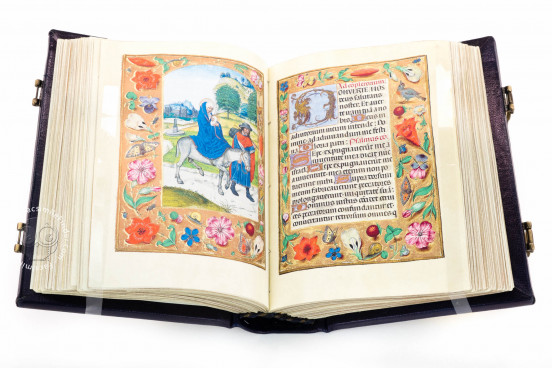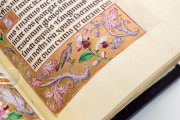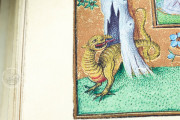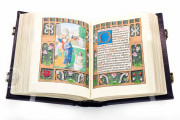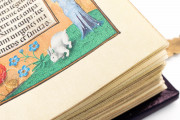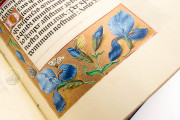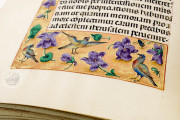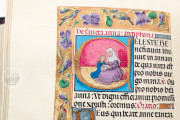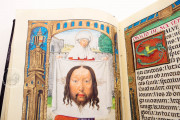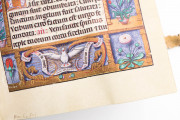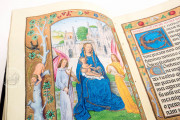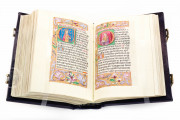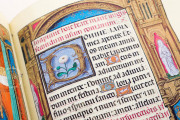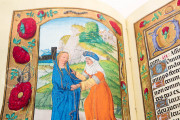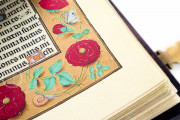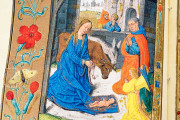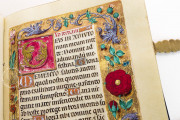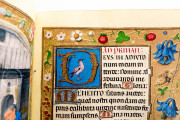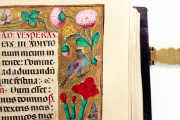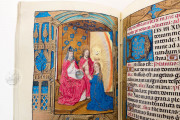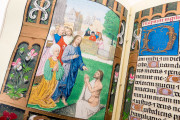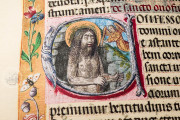Acquired for the royal library in Brussels in 1967, the Book of Hours of Alexander VI is remarkable for its numerous splendid illuminations, which constitute some of the finest miniatures of Flemish painting of the period around 1500. Its decorative program was executed under the direction of the Master of David Scenes in the Grimani Breviary, named for his work in the breviary. The book features fifteen full-page miniatures, eighteen historiated initials, and numerous decorated borders throughout.
Retaining its original binding, the manuscript begins with a calendar lusciously decorated with the zodiac symbols and the labors of the months. An assemblage of Christian prayers in Latin commonly comprising the contents of a book of hours follows, with each major division of the text heralded by an opening with a full-page miniature with a full painted border on the verso and a text page with a painted initial and border on the recto.
Participation of a Talented Panel Painter
Many of the manuscript's full-page miniatures reveal their artists' familiarity with the latest trends in contemporary panel painting. Indeed, an artist known principally for his work on panel, Gerard David, is thought to have contributed to the miniature of Saint Veronica (fol. 15v) that opens the text of the book proper (after the calendar). Above all, the masterful verisimilitude in the depiction of light and atmosphere suggests David's participation in the creation of this miniature, which bears comparison with the painter's renditions of the same subject on panel.
Framed in Majestic Borders
Complementing the true mastery of the full-page miniatures, this manuscript's borders are particularly noteworthy. These are primarily of two types: one with the typical illusionistic flowers interspersed with birds and insects, the other sublime architectural constructions.
Illusionistic Pilgrims' Badges
The borders are also significant for reflecting a special devotional practice. The suffrages to Saints James and Sebastian, which begin on facing pages, are both embellished by an array of painted pilgrim's badges in the borders. Depicted casting shadows on the green ground, these fictive souvenirs from popular holy shrines are portrayed with pearls, demonstrating their value as cherished tokens of pilgrimage. Indeed, actual pilgrim badges were sometimes inserted into personal devotional books.
Made for an Unknown Patron
The codex derives its name from the Borgia-Oms coat of arms of Pope Alexander VI (1431-1503) found in the painted border of fol. 15v. Although the manuscript may well have been made to honor the pope or for a family member, a misunderstanding in the depicted coat of arms suggests that the manuscript was not made at his behest. The only confirmed owner of the manuscript before its acquisition for the royal library in Brussels is Casimir Alphonse Couret (b. 1846) of Orléans.
A Rare Survival of an Original Binding
The book still has its original binding, which attests to its status as an elite commission. Its dark calfskin leather is blind-stamped with vegetal and animal motifs, while a pair of golden clasps keeps the manuscript shut.
We have 1 facsimile edition of the manuscript "Book of Hours of Alexander VI": Libro De Horas De Alejandro VI, Papa Borgia facsimile edition, published by Patrimonio Ediciones, 2004
Request Info / Price
